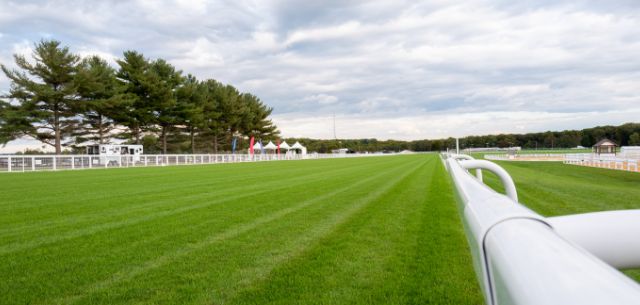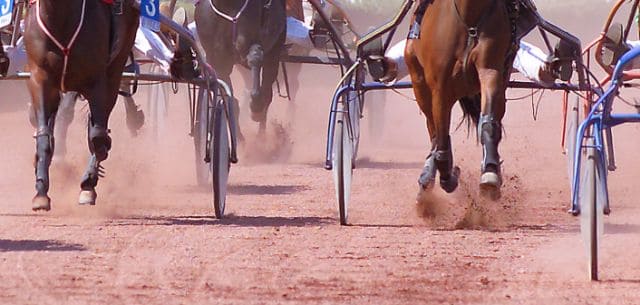Types of Horse Racetrack Surfaces and Conditions
You might get confused with many horse racetrack terms used by horse racing authors. But you have to know that there are only three major types of Track Surfaces: Turf, Dirt, and Artificial or Synthetic Tracks. Other terms like grass, tapeta, Polytrack, etc., are just synonyms or subtypes of these surfaces.
On the other hand, track surfaces also have different track conditions that can be altered by extreme weather changes. The track condition is identified by the amount of moisture in the ground, called the grading system. It is also called the going (UK and Ireland) or track rating (AUS). The turf and dirt tracks also have different track conditions, which you can learn in this article. How can this affect the performance of the horse? As horses have different track condition preferences as well. Some like a dry track, some do not. They best perform in the tracks their hooves like. Therefore, it is crucial to understand the horse and the track conditions where it would race.
Hence, pro players and bettors also note the track surfaces and conditions and check a horse’s records. As vital as it is, learning the track surfaces also earns you prize money.
DIRT TRACK

Details
- It is the first common flat horse racing surface in western society that remained dominant in the United States.
Composition
- Dirt tracks are not solely composed of dirt or soil. It is normally composed of clay, sand, and soil.
Advantages
- Dirt tracks are cheaper than artificial surface and maintaining grass or turf tracks.
- Early speed is good on dirt tracks
- Races on dirt tracks tend to have the fastest pace
Disadvantages
- Rainfall can significantly affect dirt tracks.
- Depending on the intensity of the weather, the dirt track could be good, sloppy, or muddy. It can cause accidents and unfairness to the game.
- Hence, when there is a rainfall forecast, the maintenance crew would probably “seal” a dirt track by compressing the top layer of the track. It will skim off the water, avoiding a waterlogged or swampy track.
- Natural dirt tracks do not have enough shock absorption. Hence, the hard pounding of hooves on the packed ground can increase stress on the horse’s legs. Horses who run on a dirt track most of the time or with insufficient proper training most likely get injuries.
Track Conditions
- Fast —This refers to a dry, even, and resilient surface.
When a dirt track is dry, it is labeled fast. However, the term “fast” does not refer to the speed of the racetrack. Remember that a dry track can produce slow times, and a wet track can also produce fast times.
Sometimes, it is dry enough that it requires watering in between races.
- Wet-Fast – This refers to a track with a wet surface.
This occurs immediately after a rain. The track has surface water present, but the base is still solid or firm because the moisture has not penetrated the lower layers yet.
Times on a wet-fast track can be similar or faster than fast track.
- Good – This refers to a nearly fast (dry) track.
It is a surface that is about to dry. It can be a little softer than a fast track. It may have some moisture but cannot significantly impact the horses’ performance.
- Slow – This refers to a track that is wet on the surface and base of the ground.
It has absorbed more moisture and is softer than a fast track. Horses might experience some resistance while running on this surface, producing slightly slower times.
- Muddy – This refers to a completely wet track with no standing water.
It is “deeper” and slower than a good surface.
- Sloppy – This refers to a track that had absorbed water with visible standing water.
It can significantly affect the performance of the horse.
- Sealed – This refers to tracks surfaces that have been packed down.
Machinery compacted the dirt track to seal out moisture and reduce the amount of water reaching the base. Wet tracks are sealed to produce a safe and even racing surface.
TURF TRACK

Details
- It is a natural grass track and the most popular track surface for European flat horse racing.
Composition
- A natural grass track
Advantages
- Horses can avoid more slides and slips and are generally healthier after races than when racing on dirt tracks.
- The deep grass cushion the hooves of the horses
- There are no clods and dust which would sometimes hinder the horse or jockey in racing
Disadvantages
- Race times likely take longer since it has a grass surface that sometimes lightly grabs and slows down the Thoroughbred’s stride.
- As a grass surface, owners have to maintain the grass’s length, making it harder to tend.
- Among the three track surfaces, the weather affects the turf the most.
Track conditions
- Firm – This refers to a firm and resilient turf track.
It is the standard dry and tightly packed turf surface. It has a solid footing for horses and usually produces faster times.
- Good – This refers to a slightly softer than firm track condition. It has minimal moisture.
- Yielding – This refers to a softer and more giving turf surface because of rain or watering.
Horses might sink slightly into the ground, affecting the horses’ stride and producing a slower racing pace.
It can also potentially damage their hooves (like the divots).
- Soft – This refers to a softer turf course and more giving than yielding.
It has a large amount of moisture and produces a slower racing pace.
It can also sink the horse deeper.
- Heavy – This refers to the most wet turf course.
It absorbed a significant amount of rainwater and was basically waterlogged.
Horses may struggle to keep their speed and stamina on this difficult terrain.
It is usually utilized in Europe and Australia to indicate a more saturated turf course than a soft track condition.
It is unlikely to be used in North America since race events are usually transferred to a dirt or synthetic track when extreme weather conditions occur or the turf course gets this wet.
ARTIFICIAL /
SYNTHETIC TRACK

Details
- Obviously, from its name “Artificial”, this kind of surface track is manufactured.
- In history, the first ever created synthetic surface was called Tartan turf. It is similar to Astroturf, founded in 1966. However, Tartan turf was a failure.
- It has three main types: the Polytrack, Tapeta Footings, and Cushion. They all have a gravel base with a drainage system and are almost similar.
- Other types are Fibresand, Pro-ride, Visco-Ride, and EquiPolitrek.
Composition & Subtypes
- Polytrack
- Composed of silica sand and fibers from a recycled carpet, spandex, and rubber. The entire mixture is covered with wax.
- Tapeta Footing
- Composed of sand and rubber fiber mixture which is also covered with wax. This substance makes up the top several inches and is installed on top of porous asphalt or a geotextile membrane. Drainage layers are built underneath.
- The most popular among the synthetic tracks.
- Cushion
- Combination of sand, synthetic and elastic fibers coated with wax. It is approximately seven inches deep, followed by a geotextile membrane.
- Fibresand
- Composed of Sand particles and polypropylene fiber.
- Pro-Ride
- 6 inches of footing (sand, nylon fiber, Spandex fiber coated in a polymeric binder) on top of a 4-inch IMC layer (sand & nylon fiber) on top of a drainage system.
- Visco-Ride
- Composed of Sand and fiber coated in wax
- EquiPolitrek
- Combination of silica sand, recycled synthetic fibers (carpet & spandex) and chopped geotextile. The entirety is coated with wax.
Advantages
- Unlike dirt and turf courses, the all-weather track is not affected by any weather. It has a drainage system better than natural (dirt and turf) track surfaces.
- It is the safest track compared to natural surface tracks.
Disadvantages
- Expensive to maintain
Track Conditions
- Artificial surfaces, most probably known as All-Weather tracks, employ the same rating system as dirt track conditions.
Further Information
According to some subjective observations, American bettors acknowledge dirt racing to be more predictable. Due to this, it became a more popular medium for bettors.
If you want to wager like a pro, better hit the buttons below and equip yourself with more knowledge about horse racing types and breeds. You can also check our glossary for more information and facts about horse racing.
$150 Deposit Match. Cashback Rewards.
Bet on live horse races like a Pro with AmWager.